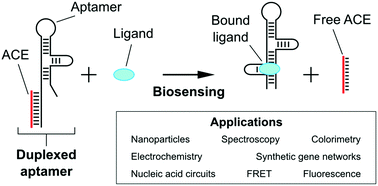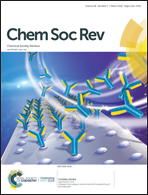Duplexed aptamers: history, design, theory, and application to biosensing†
Abstract
Nucleic acid aptamers are single stranded DNA or RNA sequences that specifically bind a cognate ligand. In addition to their widespread use as stand-alone affinity binding reagents in analytical chemistry, aptamers have been engineered into a variety of ligand-specific biosensors, termed aptasensors. One of the most common aptasensor formats is the duplexed aptamer (DA). As defined herein, DAs are aptasensors containing two nucleic acid elements coupled via Watson–Crick base pairing: (i) an aptamer sequence, which serves as a ligand-specific receptor, and (ii) an aptamer-complementary element (ACE), such as a short DNA oligonucleotide, which is designed to hybridize to the aptamer. The ACE competes with ligand binding, such that DAs generate a signal upon ligand-dependent ACE–aptamer dehybridization. DAs possess intrinsic advantages over other aptasensor designs. For example, DA biosensing designs generalize across DNA and RNA aptamers, DAs are compatible with many readout methods, and DAs are inherently tunable on the basis of nucleic acid hybridization. However, despite their utility and popularity, DAs have not been well defined in the literature, leading to confusion over the differences between DAs and other aptasensor formats. In this review, we introduce a framework for DAs based on ACEs, and use this framework to distinguish DAs from other aptasensor formats and to categorize cis- and trans-DA designs. We then explore the ligand binding dynamics and chemical properties that underpin DA systems, which fall under conformational selection and induced fit models, and which mirror classical SN1 and SN2 models of nucleophilic substitution reactions. We further review a variety of in vitro and in vivo applications of DAs in the chemical and biological sciences, including riboswitches and riboregulators. Finally, we present future directions of DAs as ligand-responsive nucleic acids. Owing to their tractability, versatility and ease of engineering, DA biosensors bear a great potential for the development of new applications and technologies in fields ranging from analytical chemistry and mechanistic modeling to medicine and synthetic biology.



 Please wait while we load your content...
Please wait while we load your content...